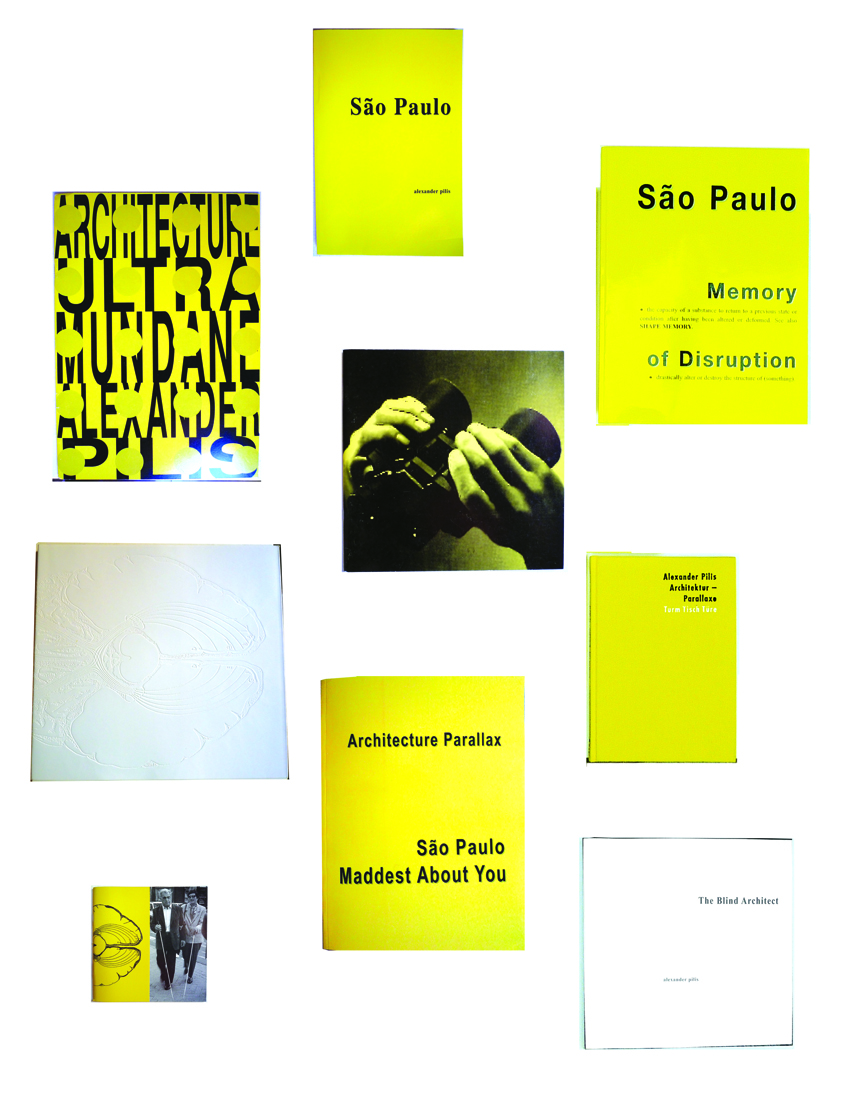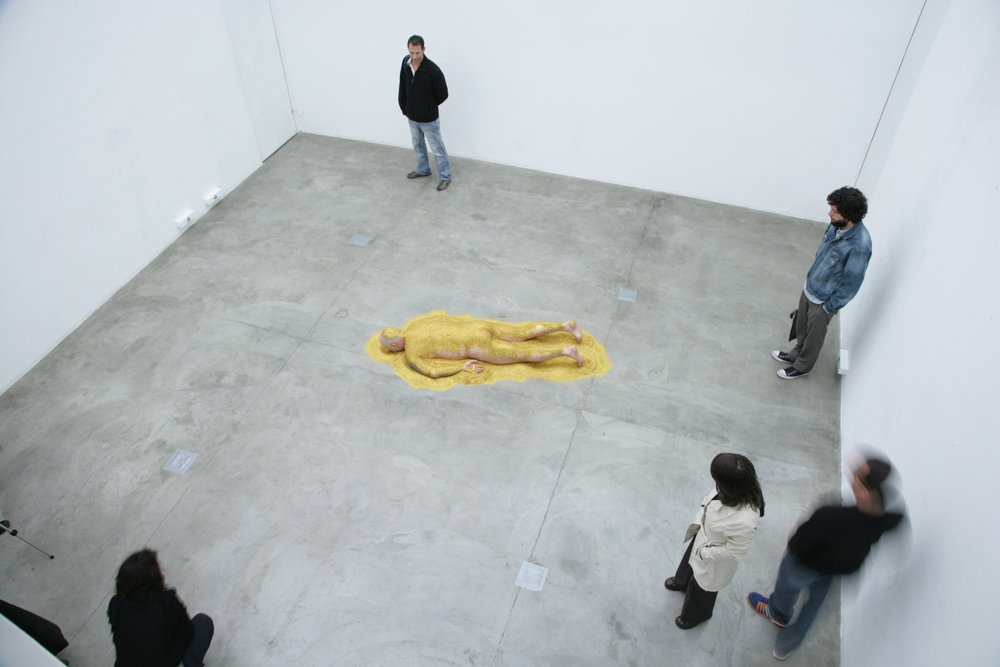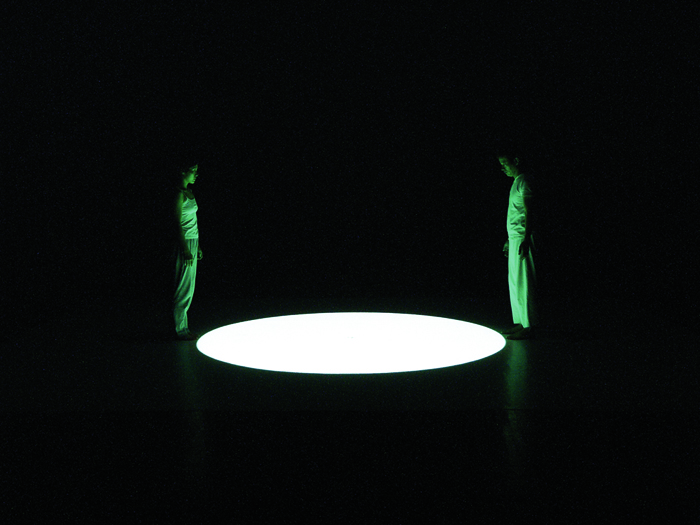“Architecture Parallax: Book Histories”, 1995-2006. Manipulates image by Alexander Pilis
The 28th Bienal de São Paulo, which runs until the 6th of December promises to be the most antagonistic – and possibly controversial – of all time. With a 40% budget cut (from an initial US$ 3.73 million, half the budget of the previous edition), a reduction from 120 to 42 visiting artists and difficulties in finding a curator, along with the challenge of staging the exhibition at all, this biennial proposes an observation and reflection upon the culture and system of biennials within the international art circuit.
To begin with, the second floor of the pavilion which hosts the exhibition, designed by Oscar Niemayer in Ibirapuera Park, will remain completely empty. In one of the installations on the third floor, the artist himself – or rather, his nakedness – becomes part of the art piece. On the third floor there are also works that deal with, somehow, the history of the Bienal de São Paulo, in addition to a library and a conference room. This biennial's relevance, however, has been very hotly debated by artists, critics, media, and, of course, bloggers.
Eduardo Ferreira [pt] provides a quick explanation for the different format, a paradigm shift from the format used since the first Bienal de São Paulo in 1951, employed for the 2008 event that even before opening had been called the “Biennial of the Emptiness”:
A exposição ficou conhecida como “bienal do vazio”, mas seu tema real é “em vivo contato”, muito pertinente para a proposta que se apresenta. Um evento das proporções da bienal, com sua importância mundial (no patamar próximo às gigantes Bienal de Veneza e Documenta Kassel), tem a função de revelar o que se tem feito de mais importante no mundo da arte, expor as “tendências” mundiais, criar diálogos regionais de modos de pensar a arte, de fazê-la, de entendê-la, e o que se faz na 28 bienal é justamente não só pensar essa produção contemporânea, mas pensar o modelo de exposição “bienal” no paradigma que vem sendo estruturado. Grandes feiras, proporções gigantescas, variedade espetacular, orçamentos monumentais, etc., a bienal desse ano vai quase que na contramão disso, chegando ao ponto de deixar um andar inteiro vazio (alvo de vandalismo por parte de determinados pseudo-artistas na busca de exposição na mídia) para tornar mais forte essa questão.
On the other hand, for Rodrigo [pt], a teacher who was already aware of the new focus when he took his students only to be disappointed at the curator's amateurism, the history of the Bienal de São Paulo should be divided into before and after the appointment of curator Ivo Mesquita, who, invited almost at the last minute, accepted the challenge refused by other curators:
Sob o ponto de vista do curador ele conseguiu o que queria: deixar a todos indignados! Mas eu acredito que a função da Bienal seja maior do que deixar o mundo indignado. O curador conseguiu! Ele acabou com a terceira maior exposição de arte do mundo! Um verdadeiro Iconoclasta!
Fábio Oliveira Nunes too left the biennial hugely disappointed at having “witnessed the worst exhibition of all time”, although he thinks that the problem was not the emptiness itself, but a succession of errors. He would recommend that people lower their expectations:
Então, simplesmente esqueça os corredores repletos de visitantes, a quantidade infindável de trabalhos, a necessidade – em todas as edições que vi – de ir mais de uma vez e os trabalhos que nos farão pensar por dias seguidos. Acredite: reserve somente uma hora do seu dia e torça para algo melhor surgir daqui a dois anos.
People are still visiting and some attractions have been very popular. Among them, perhaps the most seen in this first week was the performance by Brazilian artist Mauricio Ianês called “The Kindness of Strangers”, of which the artist's body is the centre-piece starting with a naked Ianês in the middle of the gallery. While many people have despised this as art, Santiago Nazarian [pt] enjoyed the idea:
A idéia é ele viver como uma instalação, até o final da próxima semana, dentro do Prédio da Bienal – dormindo lá, comendo lá – sobrevivendo apenas da “bondade de estranhos.” Ele começou a performance nu, mas aos poucos vai ganhando presentes dos visitantes. Segundo a Folha de São Paulo, no dia da estréia ele já tinha ganho uma camiseta, uma torta de frango, uma garrafa d'água e um “amigo imaginário”… Acho esse um ótimo exemplo de arte conceitual bem aplicada. Tem um conceito forte por trás, e está demonstrando de maneira mais incisiva e poética do que se fosse descrito como um texto – ou retratado numa pintura, ou cantado numa música. É uma performance que de fato materializa um conceito artístico, e ainda assim nem precisa ser vista para fazer sentido (ou para ser compreendida como arte).
“Dead Zone”, also by Maurício Ianês, 2007. Photo: Ding Musa
At the moment the artist is dressed and fed by visitors donations (see a video). This was one of the subjects that most attracted media attention. The other was the empitiness, which has generated a debate much bigger than the 42 invited artists. Regarding this, Lau(ra)roots says that the fundamental question is to assertain how much disturbance this “Emptiness” causes, and concludes that it, indeed, has a very uncomfortable dimension:
O vazio é o nada. É ausência de tudo. É a falta de preenchimento de algo. É oco, inodoro, incolor e quiçá insípido. É desprovido de conteúdo. É vazio.
Um tanto anacrônico considerar a proposta do vazio na 28º Bienal de Artes de São Paulo sendo algo de vanguarda. A todo o momento somos estimulados a lidar com a complexidade do múltiplo, o acúmulo material e intelectual, o preenchimento do tempo e do espaço a fim de suprir as necessidades existentes. Somos impulsionados ao consumo. A satisfação do ser está intimamente ligada ao ter. A felicidade é moeda de troca: só é feliz aquele que se realiza ao mesmo tempo na vida pessoal e profissional.
Quando há o vazio, há a impressão de que algo saiu errado. Logo somos levados a crer que os objetivos não foram alcançados; falhamos. Existe uma incompetência subtendida no conceito do vazio que chega a superar a própria percepção da ausência. Pode-se dizer que a angustia que toma conta de nossos sentidos chega ser um alento, pois ela preenche a sensação do nada que havia até então.
It is somewhat anachronistic to consider the 28th Sao Paulo Biennial of Art's presentation of the emptiness as something avant-garde. We are the whole time encouraged to deal with the complexity of multiplicity, intellectual and material accumulation, filling time and space to meet existing needs. We are driven to consumption. The satisfaction of being is closely linked to having. Happiness is a currency: only those who have accomplishments in personal and professional life are really happy.
When there is an emptiness, there is the impression that something has gone wrong. We are soon led to believe that goals were not achieved; we failed. There is an implicit incompetency in the concept of emptiness that reaches beyond ones own perception of absence. You could say that the anguish that takes up our senses is even cheering because it replaces the sensation of the nothing that we had until then.
And when it does not fill up, the emptiness is filled up. At around 19:35 last Sunday, the first day of the biennial, a group of about 40 graffiti vandals invaded the pavilion and painted the walls on the second floor, the one left purposely empty. The group, headed by an artist known as Pixobomb, took advantage of this to fill the walls with phrases like: “This is what art is”, and their tags, Susto, 4 and Segredo. Ana Paula Freitas [pt] is not sure if she believes Mauricio Ianês’ performance is art, but in case it is, what would make it “different” from the graffiti “demonstration”?
O que separa esse tipo de ação da ação dos outros caras? No caso do Pixobomb, ele diz que as invasões são um manifesto contra a capitalização do grafitti, que foi concebido como uma arte ilegal. Ianês, segundo o UOL, pretende com sua instalação “questionar a comunicação entre artista e público, e a responsabilidade do trabalho nesta comunicação.” Oi? É triste, mas a justificativa dos pichadores é muito mais coerente e bem menos hermética. (…) E aí? Qual dos dois é mais arte, qual dos dois é mais questionador? O pelado que quer contestar a relação entre arte e o público (ou seja, até existe uma relação com o terrorismo poético, que também questiona e subverte essa relação) e é aclamado por isso ou o bando de pichadores, que invade uma galeria de artistas engomadinhos para pichar uma parede vazia e com isso contestar o que é estabelecido como arte?
For most bloggers, the biennial has indeed seen better days. Actor and artist Diego Miguel [pt] remembers that 55 years ago, Bienal de São Paulo brought to Brazil artists who were at the cutting edge of contemporary art, such as Klee, Calder, Mondrian, Henry Moore, De Konning, Munch, Léger, Braque, Picasso. The blogger says it loud: “How I wish to go back in time!”
Conceito? Não! Seria hipocrisia de nossa parte, enquanto artistas, acreditarmos em tal afirmação.
Para comprovar isso, podemos pensar no objetivo da Bienal: mostrar o que há de melhor na arte contemporânea, o que os artistas atuais estão fazendo. Seria mais honesto admitir a falência da Bienal e a redução da verba para exposição (de 18 milhões – Bienal de 2006 para 09 milhões – Bienal de 2008).
To prove this, we can think of the biennial‘s goal: to show what is the best in contemporary art, what the artists are doing today. It would be more honest to declare the biennial bankrupt and cut funding for the exhibition (R$18 million – 2006 biennial – to R$9 million – 2008 biennial).
Weightless Days, 2006. Collaborative work by artists and designers Angela Detanico and Rafael Lain, dancers and choreographers Megumi Matsumoto and Takeshi Yazaki, and musician and artist Dennis McNulty
To conclude, see S…‘s post, which illustrates very well what many bloggers think about this year's biennial.










7 comments
Prezada Paula Góes,
Antes de tudo, obrigado por visitar meu blog e por citá-lo no seu blog, volte sempre.
:-)
Gostaria de corrigir uma parte do que vc disse sobre minha opinião… “only to be disappointed at not finding anything interesting,…”
it´s not true… => I dont saw that…
Eu encontrei muita coisa interessante… meu questionamento está na favelização da bienal, as obras de arte lá expostas demonstram grande questionamento e expressão e isso é bom. Não foram os artistas e sim o curador que gerou minha indignação! O amadorismo da organização e a sugeira do lugar!
Abraços
Rodrigo Vieira Ribeiro
Obrigada, Rodrigo!
E desculpe por ter interpretado você mal. Mas não foi nada pessoal, :)
Eu consertei o artigo de modo a expressar melhor o seu ponto de vista, mas o trecho do seu post que tinha me feito interpretar que você não tinha encontrado nada interessante foi esse abaixo, que vinha imediatamente antes do trecho que escolhi para traduzir:
“Cheguei na vigésima oitava bienal… sabendo dos novos questionamentos e das propostas veiculadas na mídia. E o que encontrei?
Nada!
O ZERO completo à esquerda!”
Tudo de bom
Paula
Obrigado Paula!
Você é muito gentil!
Talvez para evitar o campo da polissemia eu devesse ter escrito “o nada”… mas preferi deixar somente “nada” para demonstrar mais o meu descontentamento.
Tudo de bom para vc tb!
Abraços
Rodrigo
Com tanto artista espalhado pelo mundo querendo expo na bienal…que decepcao!
Quem decide sobre o curador da bienal entende alguma coisa de arte? Quantos museus, feiras de arte or galerias internacionais eles ja visitaram?
Olá! Primeiramente, obrigado pela citação! Me sinto honrado!
Quanto à bienal em si, escrevi o post antes de visitá-la (tanto que nele não deixo opinião pessoal alguma, apenas uma explicação do que seria esse vazio todo). De qualquer maneira, após visitá-la, ainda penso ter sido uma experiência bastante interessante. Esse “vazio” tomou demasiado “espaço” nas discuções, deixando a discução da bienal, das obras, dos artistas, da instituição falida, etc., pra segundo plano, esquecendo-se a metáfora à qual estava associado, infelizmente.
A exposição em si possui obras de extrema qualidade, outras nem tanto, e vale sim uma visita. E espero que esse vazio não afaste as pessoas pelo que a mídia tem veiculado.
Abraços!